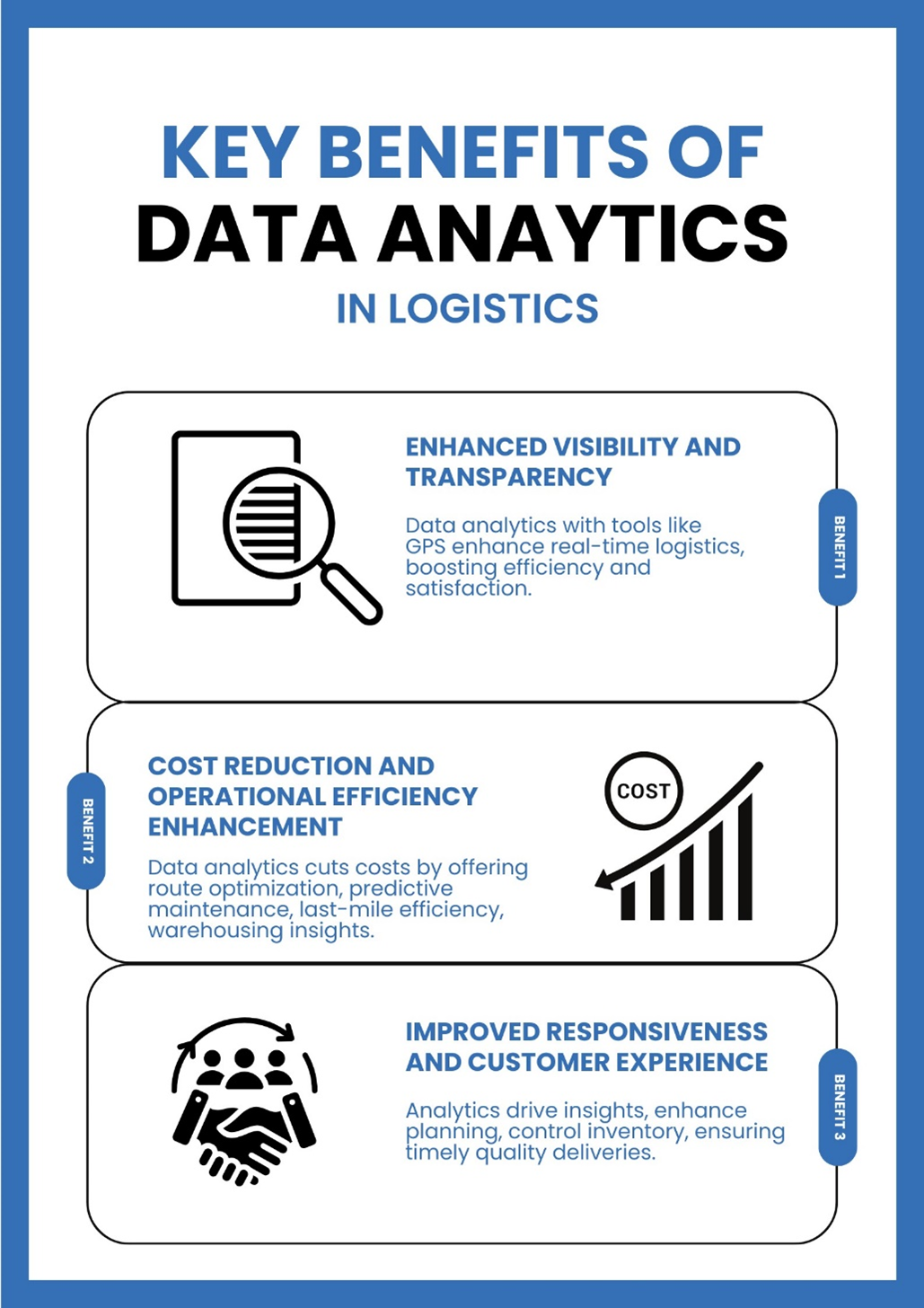ƒusing ƒƒ
Ever thought about what it would be like to know exactly when a delivery truck will reach its destination or find out where problems will occur before they do? It might seem like a dream, but you can make it a reality by using special tools that help analyze and report information in your transportation and logistics business.
For a company that handles moving things around, gathering information i.e., data is important. You need to know things like how the vehicle is doing, the condition of the roads it travels on, and how much fuel it uses. It’s also helpful to have information about the drivers, like how many there are, how they’re performing, and how long it takes them to leave the warehouse. Having all this information can help figure out the best ways to improve operations and increase efficiency
Long story short, data analytics plays a key role in logistics and transportation businesses. This is our topic to discuss today! Keep reading, and you’ll learn:
-
-
- What are data analytics in logistics?
- How logistics can be better with Data analytics?
- How to make it happen? and
- Why can you trust 7T to help with all of this?
-
Using Data Analytics in Logistics
Data analytics in logistics involves gathering, processing, and examining large volumes of datasets pertaining to the management of logistics operations. Utilizing tools such as sensors, GPS devices, RFID tags, and enterprise resource planning (ERP) systems contributes to a holistic approach that enhances various aspects, including transportation, inventory control, warehouse management, demand forecasting, and overall supply chain optimization.
Many transportation companies have already embraced a data-driven approach to decision-making. According to the Inbound Logistics Report,
-
-
- Electronic Data Interchange (EDI) remains crucial in logistics, with 94% of 3PLs providing this capability.
- Newer technologies coexist with EDI for data sharing.
- 3PLs offer IT solutions for day-to-day logistics operations:
- Transportation management (86%)
- Visibility (78%)
- Customer/supplier relationship management (65%)
- Warehouse management (63%)
-
-
-
- 3PLs provide technologies for assessing and improving operations:
- Supply chain design solutions (57%)
- Predictive analytics (49%)
- 3PLs provide technologies for assessing and improving operations:
-
The advantages of employing technologies built on the foundation of data analytics in logistics are substantial. Let’s explore the impact of data analytics on logistics:
-
-
- Machine Learning (ML): ML algorithms recognize patterns and trends within logistics data, such as delivery times, transport routes, and inventory levels. Analyzing these patterns enables logistics companies to optimize operations, enhance supply chain visibility, and make well-informed data-driven decisions.
- Artificial Intelligence (AI): AI automates logistics scheduling and routing by utilizing predictive analytics. This assists logistics companies in anticipating potential issues and proactively mitigating risks. For instance, in warehouse management, data analytics utilize artificial intelligence to enhance warehouse layouts, optimize fleet routes, and streamline inventory management processes.
- Internet of Things (IoT): IoT sensors capture real-time data on shipments, vehicles, and warehouse operations. Analyzing this information facilitates the optimization of supply chain visibility and decision-making. For example, IoT sensors track inventory levels, monitor the condition of goods in transit, and maximize the utilization of warehouse space.
-
Key Advantages of Utilizing Data Analytics in Logistics

The integration of data analytics offers numerous benefits to logistics companies. Let’s dive into the most critical advantages:
-
-
- Enhanced Visibility and Transparency
By employing data analytics together with GPS devices and other tracking tools, logistics companies can monitor the real-time movement of goods. This information, coupled with data on traffic, fleet status, and on-road conditions, enables logistics managers to plan and schedule deliveries efficiently, considering factors like weather conditions or potential accidents. The result is increased transparency that boosts customer satisfaction through real-time tracking information, fostering trust. This approach not only improves logistic operations’ efficiency but also provides customers and partners with real-time updates on parcel delivery status, along with automated notifications for any anticipated delays. - Cost Reduction and Operational Efficiency Enhancement
Data analytics in logistics offers various possibilities for cost reduction and improvement of operational efficiency. To name a few:-
- Route Optimization: Advanced analytics can identify the optimal delivery route by analyzing data from vehicle sensors, weather reports, and traffic updates. This leads to significant cost savings, primarily through reduced fuel consumption.
- Predictive Maintenance and Driving Optimization: Analytics systems drive habits, identifying inefficient practices that can be rectified. Fleet condition data enables proactive maintenance, resulting in reduced fuel consumption and fewer delays due to vehicle breakdowns.
- Last-Mile Delivery Efficiency: Data analytics address cost-related challenges for last-mile delivery, optimizing processes such as working with carriers, manual processes, driver retention, fuel costs, WISMO calls, and return expenses. By analyzing information across all stages of the delivery process, logistics companies can optimize their strategies and identify specific patterns for efficiency gains.
- Efficient Warehousing: Data analytics provides warehouse managers with insights into loading, carrying, and unloading processes. Understanding changes in customer behavior and expectations allows for improved route planning and delivery scheduling, enhancing warehouse throughput.
- Improved Responsiveness and Customer Experience
-
- Enhanced Visibility and Transparency
-
By leveraging analytics, managers gain insights into market dynamics, predict future trends, segment customers, and identify new sales opportunities. This in turn offers efficient planning and stronger control over inventory management. Thus, logistics companies can deliver quality products on time, meeting evolving consumer demands. It leads to more satisfied customers.
Implementing Advanced Analytics and Reporting Tools in Your Company
I’m sure it’s clear now that to stay ahead in the transportation and logistics industry, it’s crucial to use advanced logistics analytics and reporting tools in your company. If you’re thinking about how to do this, let’s take a closer look.
To seamlessly integrate these tools into your operations, follow these steps:
-
-
- Assess Your Data Infrastructure:
Begin by evaluating your current data infrastructure. Determine if any upgrades or changes are necessary to support advanced transportation analytics. This might involve investing in new technology or software solutions capable of handling large volumes of real-time data. - Identify Key Impact Areas:
Identify the key areas where advanced analytics can make the most significant impact on your business. This could involve forecasting demand, optimizing routes, or identifying cost-saving opportunities. Focusing on specific goals allows for effective resource allocation and facilitates the measurement of success in your analytics initiatives. - Gather the Right Data:
Once goals are identified, gather the right data for analysis. This may require integrating data from various sources, including customer records, supply chain data, and operational metrics. Ensuring the collection of accurate and reliable data is crucial to generating meaningful and actionable insights. - Select Appropriate Reporting Tools:
Choose the right reporting tools for your company. Look for tools that provide customizable reports and visualizations, enabling you to present data in a way that is relevant to your stakeholders. This ensures better decision-making and an overall improvement in performance. - Train Your Team:
Finally, train your team effectively using advanced analytics and reporting tools. Conduct training sessions and workshops to ensure that everyone comprehends how to interpret the insights generated and leverage them to drive success. This step is crucial in maximizing the benefits of implementing advanced analytics in your operations.
- Assess Your Data Infrastructure:
-
Unlock the Power of Data Analytics with 7T’s Digital Transformation Services
At 7T, we provide customized data analytics solutions crafted to address the specific challenges encountered in the logistics sector.
Our team of specialists is prepared to assist you at every stage of your data analytics venture, from integrating and analyzing data to implementation and continuous support. Choosing us means picking a reliable partner with a track record of helping businesses, just like Simplex, streamline operations and stay competitive in this ever-changing industry.
Reach out to us today and kickstart your journey toward data-driven success.










